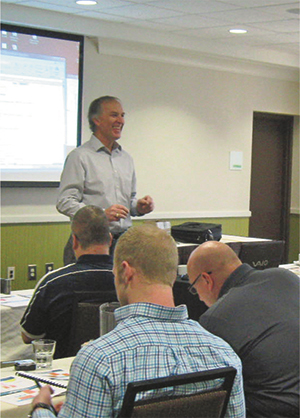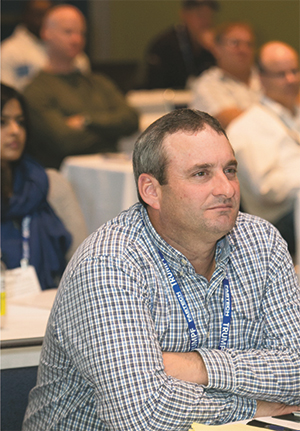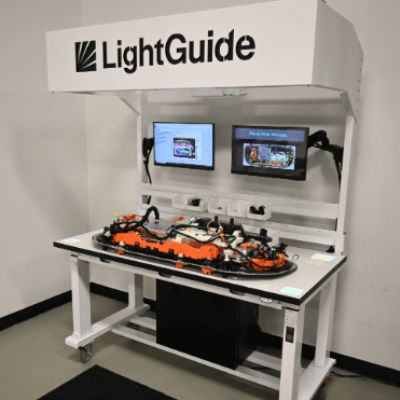Separating Fact from Friction
The Irmco iTool is designed to perform stamping-lubricant performance tests based on Dr. Taylan Altan’s cup-draw research at The Ohio State University and EWI. With the iTool housed in a 300-ton servo press, stamping companies and material suppliers can test and verify lubricant performance with statistical accuracy.
W. Jeff Jeffery and Mark Mrozik, Irmco
10:30 a.m.-12:30 p.m.
Material Properties
Understanding Material Properties and Deformation Modes to Solve Metalforming Problems in the Press Shop
Important relationships exist between material properties, basic forming modes and die operations. Understanding these relationships increases one’s comprehension of the problem and the ability to identify the best solutions. This presentation offers a basic understanding of material properties and basic forming modes so that the user can identify and solve formability problems efficiently and effectively.
Peter Ulintz, Precision Metalforming Association
Error Proofing
Sensors for Error Proofing Stamping, Metalforming and Assembly
This session will cover basic and advanced applications of sensors for die protection and automatic in-die part-quality measurement.
George Keremedjiev, Tecknow Education Services, Inc.
1:30–3:30 p.m.
 Tool Steel And Heat Treatment
Tool Steel And Heat Treatment
Effective Utilization of Tool Steel: How to Meet the Challenge of Demanding Stamping Applications
Toolmakers have many options concerning tool-steel products and related treatments. Attendees will receive practical advice on how to make better informed choices and achieve a higher level of optimization of the tool-material variables that come into play with demanding applications.
Gary R. Maddock, Tri-Star Metals
Improving Die Life Using Failure Analysis and Proper Tool-Steel Selection
This presentation will show real-world examples of tooling issues and offer ways to address these issues by recognizing the root cause. The presentation also will discuss tooling alloys and their properties, highlighting how proper material selection can improve die life by addressing some of the failure mechanisms.
Ed Severson, Bohler-Uddeholm Corp.
In-Die Technologies
Exploring the Benefits of In-Die Fastener Installation
In-die fastener-installation systems can improve productivity and quality while simultaneously increasing throughput and reducing work-in-process. A description of the individual elements of an in-die system and how they function together to form a complete system will be explained through graphics and animations. Also covered are typical and unique projects including the latest technologies associated with installation of microfasteners.
Roger Patton, PennEngineering
Automatic In-Die Part Quality Monitoring and Tool Adjustments
Implementation of part measurement, die adjustment and part tracking can result not only in 100-percent verification of critical part features, but also in significantly increased machine utilization, accurate production, reduced scrap rates and more reliable die protection. Learn the practical methods to select, apply and integrate sensors and control systems in order to fulfill accuracy and quality requirements.
James Barrett, Link Systems, Inc.
Thursday, November 17
8–10 a.m.
Formability Analysis
Sheetmetal Formability Analysis, Engineering, Simulation and Production
This session introduces metalforming analysis, process engineering, and metalforming finite-element analysis techniques and tools. Topics covered include sheetmetal stamping and die basics, sheet and tube mechanical properties, strain analysis for prediction of formability, common failure modes of sheetmetal parts, circle-grid and thinning analysis and finite-element analysis of sheetmetal-stamping processes.
Kidambi Kannan, AutoForm
Sensor Basics
Die Protection and Sensor Basics
This program covers die-protection strategy, control logic, sensor selection, installation and wiring. Learn the three most useful sensor types for in-die use, the five most common mistakes made by novice sensor users and the one specification that best relates to sensor longevity in a harsh environment.
Jim Finnerty, Wintriss
10:30 a.m.–12:30 p.m.
Solving Progressive-Die Problems
Solving Progressive-Die Problems—Challenges and Practical Solutions
This presentation provides a methodical approach to solving complex problems associated with progressive dies. Several testing procedures, performed with the die in the press, are presented to assist in isolating and identifying the root cause of common problems.
Peter Ulintz, Precision Metalforming Association
Press Maintenance
21st-Century Press Maintenance: A New Approach
This presentation will discuss methods to make your press-maintenance activities lean by reducing costs, while at the same time increasing overall effectiveness. We will examine how to use existing press systems such as tonnage monitors, brake monitors, lubrication systems and die protection as effective tools to monitor overall press condition, and look at how electronic monitoring provides markers that trigger further mechanical inspection.
Jeff Fredline, Industrial Maintenance Company, LLC
1:30–3:30 p.m.
Lubrication Technology
Lubrinomics—The Science of Lubrication and Economics in Metal Stamping
Lubrinomics is the study of the economic activity and strategies that govern the production, distribution and consumption of metal-stamping lubricants. Learn how to develop processes for proper dilution and control of process lubricants, the different compositions available and how to best apply these to your specific operation.
Steve Lowery, Tower Oil & Technology Co.
Sheetmetal Lubrication: Reducing Costs and Maintenance While Improving Safety and the Environment
The costs associated with lubricants are numerous, i.e., application equipment, the lubricant itself, plant maintenance, safety and environmental issues. After a brief overview of the issues and problems related to the lubrication process, a new spraying technology will be introduced, along with case studies illustrating the cost savings stampers are experiencing.
Ron R. Demonet, Atlas Technologies, Inc.
Utilizing the Updated ANSI Z244.1 Control of Hazardous Energy Servicing Exceptions to Benefit Machine Productivity
OSHA introduced 1910.147 regulations in the late-1980s, based on the document issued by ANSI/ASSE known as Z244.1. With the release of an updated Z244.1 in 2016, language for the control of hazardous energy has been updated to include current technology, and be forward-thinking in terms of how to utilize this technology for enhanced operator and machine efficiencies. The presentation will review the updated language in Z244.1 and provide examples on how it can apply in the production environment.
Ted Sberna, White Horse Safety
Friday, November 18
8–10 a.m.
Springback Analysis
Springback: Recognizing, Predicting and Responding to Variation in Sheetmetal Stamped Parts
In this session, participants will apply knowledge of core mechanical principles of stress and strain and properties of sheetmetal to identify sources of variation in stamping processes; correlate mechanical properties such as yield stress and elastic modulus to springback; recognize characteristics of dies and stamping processes on springback effects; identify methods to predict and address sheetmetal springback during design and engineering; and define reasonable expectations of springback and stamping-process repeatability.
Jonathan Varner, AutoForm
Modern Press Technology Increase ROI with Turnkey
Hot-Stamping Solutions
This presentation will cover simulation and method planning and the process steps to evaluate the feasibility of producing parts by hot stamping. Learn about modifying and optimizing the part based on simulation results. Also explained will be the common challenges to using the process, including part quality, output rate and process monitoring.
Paul Thom, Schuler Inc.
Servo-Press Technology and Return on Investment
This presentation will cover servo-press technology and return on investment, and provide an overview comparison of mechanical vs. servo-press technology. You’ll be shown the advantages of servo, and learn the benefits of using custom motion profiles including full stroke vs. pendulum stroke.
Barry Lewalski, Schuler Inc.
10:30 a.m.–12:30 p.m.
AHSS Tooling Technology
Latest-Generation Hybrid Blanking Lines
Learn about the latest tendencies and trends in blanking advanced high-strength steels and aluminum. The process to obtain blanks made of these materials requires new and advanced technology. New hybrid blanking installations have been created by adding new levelers, servo-blanking presses, stackers and automation.
Victor Esteban, Fagor Arrasate USA, Inc.
Cold-Work Die Steel: Development and Application
Due to increased stress when stamping high-strength steels, proactive measures against tool failures such as chipping and cracking are required. Matrix-type cold-work die steel, DCMX, has been developed to tackle these problems. DCMX provides a much higher toughness than does D2, and has superb machining efficiency and simple dimensional control in heattreatment.
Kunio Namiki, Daido Steel Co., Ltd.
In-Die Sensing
How In-Die Sensing and Press Setup Technologies Enable Quick Die Changes and Prevent Die Crashes
Teams in stamping operations need to identify quality issues early and adjust quickly so that they can have zero defects shipped to the customer. This is readily accomplished through in-die process validation, electronic measurement and part traceability. Through real-world examples, this session will discuss how press shops are successfully implementing error proofing, preventing die crashes and implementing quick die changes.
Will E. Healy, III and Dave Bird, Balluff Inc. MF
Technologies: Coil and Sheet Handling, Management, Fabrication
 The FABTECH 2016 Education Program promises to provide exceptional learning opportunities for metalforming- and fabricating-company employees at every level, from the plant floor to the executive suite. Technical sessions are presented by the Precision Metalforming Association (PMA), Fabricators & Manufacturers Association, SME and Chemical Coaters Association International. Among the topics covered: cutting, finishing, forming and fabricating; management and job-shop solutions; automation and robotics; stamping; and tube and pipe. And, the American Welding Society presents a comprehensive lineup of welding education, including the Resistance Welding School.
The FABTECH 2016 Education Program promises to provide exceptional learning opportunities for metalforming- and fabricating-company employees at every level, from the plant floor to the executive suite. Technical sessions are presented by the Precision Metalforming Association (PMA), Fabricators & Manufacturers Association, SME and Chemical Coaters Association International. Among the topics covered: cutting, finishing, forming and fabricating; management and job-shop solutions; automation and robotics; stamping; and tube and pipe. And, the American Welding Society presents a comprehensive lineup of welding education, including the Resistance Welding School.









 Podcast
Podcast